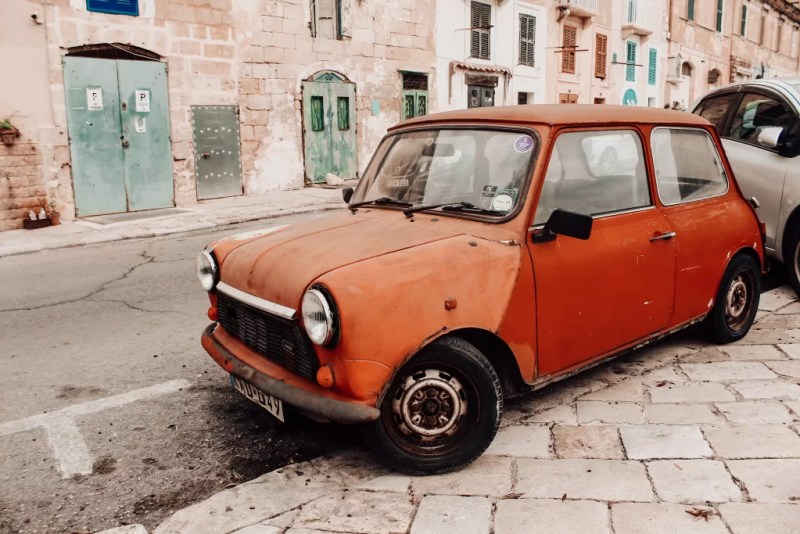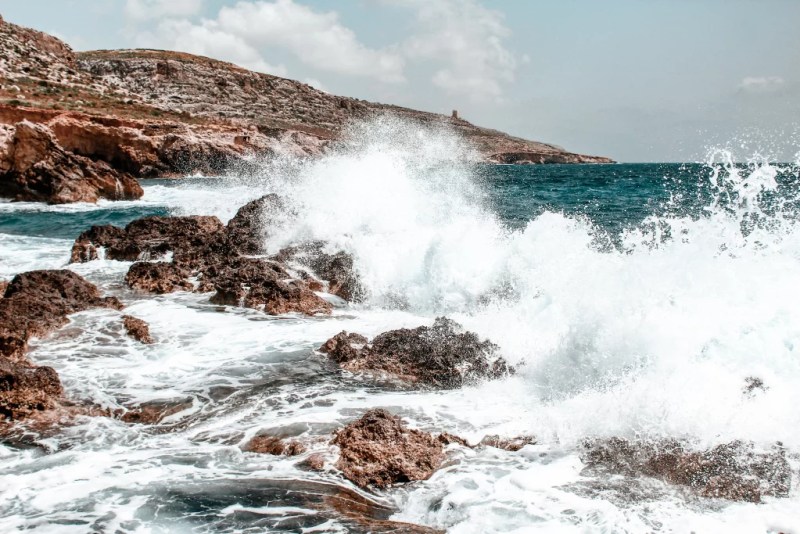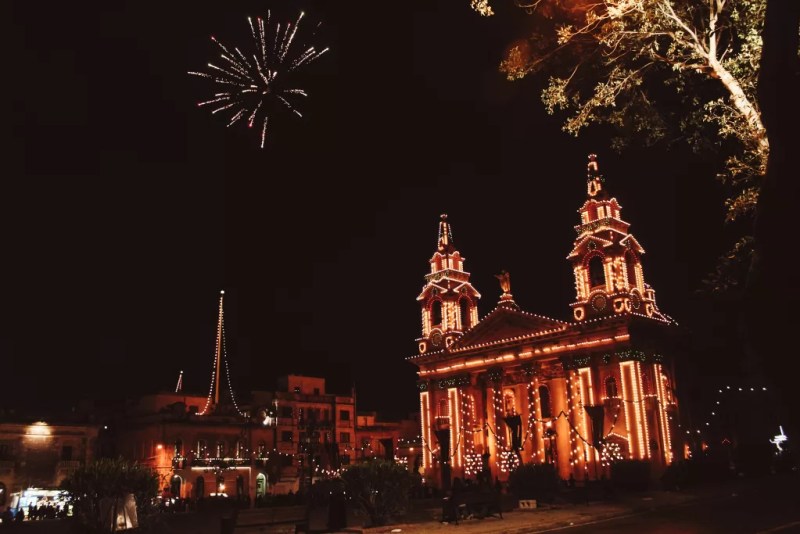If you’re looking for some tips for visiting Malta, you’ve come to the right place. As a native, I love sharing my honest advice with visitors.
For example, while Malta is often marketed as the ideal summer destination, I advice against visiting the island between June and September. Plus, although places like the Blue Lagoon may seem idyllic on Instagram, in reality they’re teeming with people and boats.
So, here are my insider tips for Malta.
Some quick facts about Malta:
- Language: Maltese and English
- Currency: Euro
- Capital city: Valletta
- Population: Around 519,000
- Electricity: 230 Volts, 50Hz, 3-pin plugs
- Driving side: Left
- Religion: Roman Catholicism
1. Visit the island between October and May
Malta is a popular summer destination. However, if you really want to make the most of your stay in Malta, avoid visiting the island in summer.
The best time to visit Malta is from October to May, when the streets aren’t chockablock with noisy crowds and traffic, and the temperatures are mild.
This means you can explore the island’s attractions without having to seek refuge from the heat and the crowds every five minutes.

If you’re a beach lover, you can still go for a dip in the sea on a beautiful day (we get plenty of them in spring and autumn) – you might even have the whole beach to yourself!
Additionally, the weather at this time of year is perfect for hiking.
2. Explore Malta beyond the beaches
Malta is a popular sun and sea destination. But there’s more to the island than its gorgeous beaches.
For instance, did you know that Malta is home to some of the oldest standing structures in the world?


The Megalithic Temples of Malta were built during the 4th and 3rd millennium BC, while the Hypogeum, an underground prehistoric site, is one of the most fascinating places on the island.
Meanwhile, Valletta is packed with architectural gems, including Baroque palaces and churches that house priceless artworks.

The ancient city of Mdina is another must-see, although I highly recommend visiting in the evening to avoid the crowds.
If you’re looking for more amazing things to do in Malta, take a trip to Birgu and Isla, where you can immerse yourself in local history and take in beautiful views of the Grand Harbour.
3. Stay in a traditional Maltese village
For a truly authentic experience in Malta, I highly recommend ditching the pricey and tacky hotels in Sliema, St. Julian’s and St. Paul’s Bay for a cosy guesthouse in a traditional town.
For instance, Palazzo Bettina in Birgu offers a truly immersive experience in the south of Malta. This boutique hotel is housed in a 17th-century palace, and has a rooftop pool area with stunning views over the harbour.


Meanwhile, Casa Azzopardi Guesthouse in Rabat is a great base for anyone who wants to stay in a gorgeous Maltese townhouse and explore local culture.
Another great location is the fishing village of Marsaxlokk in the south of Malta. You can stay at a guesthouse close to the seafront and watch local fishermen at work.
For example, Quayside is a self-catering accommodation housed in a renovated 19th century building.

You can buy fresh seafood from the Marsaxlokk fish market and cook it at the apartment.
4. Pack waterproof clothes
Contrary to popular belief, it does rain in Malta. And when it does, it’s biblical.
Rain in summer is highly unlikely, but we do get some apocalyptic storms in autumn and winter (normally they only last a day or two).

The weather in Malta tends to be unpredictable in winter. One minute you’re soaking up some sun and the next you’re dashing for the nearest shelter. Therefore, you might want to carry a jacket with you just in case.
5. Indulge in local food
Maltese cuisine is divine. From popular snacks like ftira and pastizzi, to hearty meals like baked pasta and pork stew, there are several Maltese foods and dishes you must try.

If you’re a meat eater, make sure you treat yourself to a fenkata – a traditional rabbit meal.
Meanwhile, seafood lovers can indulge in a variety of fish dishes, including fried lampuki, octopus stew, stuffed squid and baked tuna steaks.

Many restaurants in Malta tend to serve large portions with a complimentary side of bread. For authentic Maltese cooking, look for small family-run restaurants in traditional towns like Mgarr, Marsaxlokk and Rabat.
6. Avoid using buses in summer
Malta has always had an inefficient public transport system and it gets worse during the summer months (another reason not to visit Malta in summer).
Expect long delays, packed buses, crowded bus shelters, and slow traffic when travelling on popular routes, especially on buses to Valletta, Sliema, Bugibba, Mellieha and Cirkewwa.
Also, orderly queues are almost non-existent in Malta, so you might have to push your way onto the bus.
Buses run more efficiently during the off-peak season, but you should still consider renting a car if you want to get off the beaten track in Malta.
7. Drive carefully
Hiring a car is the best way to get around Malta and Gozo. However, driving in Malta requires stamina.
Due to the increasing number of cars on the island, the roads are always busy. Reckless driving is also a problem, so drive carefully and try to avoid arterial roads during rush hour.

Driving through the countryside is less stressful, but you will encounter several roads in bad condition (and large potholes!).
Also, some of the paths are narrow and two-way, so it’s always a good idea to honk your car horn before going around a bend.
8. Be prepared for long traffic jams
Malta has a major traffic problem. There are just too many cars on the island and public transport is not a popular option among locals (even though it’s free).
If you’re visiting Malta in summer, expect frequent bus delays, congested roads and overcrowded buses on popular routes.
With the exception of the morning and evening rush hours, the traffic isn’t too bad in winter unless it rains. Malta’s poorly designed roads are prone to flooding, leading to total chaos every time the island is hit by heavy rain.
If you’ve booked a tour or activity, try to get to your destination early. A 30-minute drive can easily turn into 2-hour journey.
9. Spend two full days in Gozo
Gozo may be a third of the size of Malta, but there’s plenty to see and do on the island.
Tourists often make the mistake of thinking that they can see all of Gozo in one day. While one day is all you need to see the main sites, I highly recommend spending two days exploring Gozo at your own pace.

If you want to get off the beaten path in Gozo, you can walk along the rugged coastline, go for a swim at a secluded beach, and explore the island’s picturesque hamlets.
10. Expect a lot of noise and dust
Malta’s ever-growing construction industry has turned touristy places like St. Paul’s Bay, Sliema and St. Julian’s into overpopulated concrete jungles.
Sadly, traditional buildings are constantly being demolished and replaced by large apartment blocks or new hotels. You can find a construction site on almost every street in Sliema and St. Paul’s Bay (and that’s not an exaggeration).

If you want to experience the magic of Malta, try to base yourself in a traditional town or village and spend at least a day or two exploring the island’s beautiful countryside.
Meanwhile, Gozo is more peaceful than Malta and most of its traditional towns remain largely undeveloped.
11. Be wary of the sea
While Malta has some stunning beaches, the sea can be very unforgiving. Every year, several people die after being swept away by waves or currents.
Only swim in designated swimming areas and don’t get too close to the shore when the sea is rough.

Also, avoid jumping off cliffs or walking along cliff edges. Malta’s coastline is battered by violent waves in winter, which cause fissures in the rocks that often lead to parts of the cliffs collapsing.
Worried about jellyfish? The kinds of jellyfish you find in Maltese waters are not dangerous, although their sting can be very painful. They’re normally pinkish so they’re a bit easy to spot.
You’ll also want to watch out for sea urchins when swimming in rocky bays.
Tip: Download the WhichBeach app to see which beaches are safe on the day you want to go swimming.
12. Avoid Paceville like the plague (unless you’re a party animal)
Paceville is often promoted as the perfect place for a great night out, but it’s really not. Picture an overdeveloped and congested area brimming with grubby nightclubs playing deafening music, rowdy groups, and intoxicated people.
In short, Paceville is a hellhole.
If you want to enjoy a bottle of wine in a less chaotic setting, spend the evening bar-hopping through Valletta.
Some of my favourite Valletta wine bars include:
- Trabuxu: This wine bar on Strait Street is housed in a 400-year-old vaulted cellar. It is known for its wide selection of wines and delicious cheeses.
- Gugar: This friendly and colourful bar is the perfect place to unwind with a nice drink. This bar also houses a tiny library and art gallery, and serves many vegan snacks.
- San Paolo Naufrago: Mingle with locals at this traditional Maltese cafe, which serves a variety of snacks, including wraps and salads. You can chill out on the steps outside or just enjoy the bar’s cosy atmosphere.
You’ll also find some really nice wine bars in Rabat.
13. Make a note of the bird hunting seasons
Bird hunting is a popular ‘sport’ in Malta and it’s actually legal, despite being a threat to certain bird species.
Illegal hunting is a common crime. Every year dozens of protected birds are shot.

If you’re visiting Malta during the bird hunting season and you’re planning to go hiking, you must take a few precautions. Quite often, unsuspecting hikers are assaulted by hunters for trespassing on privately-owned land (often marked as RTO – restricted to outsiders).
Stick to marked hiking trails and well-trodden paths and you should be okay.
14. Don’t bother going to Comino in summer
Comino’s Blue Lagoon looks like paradise in photos, but you might up end up being sorely disappointed when you get there.
In summer, boatloads of tourists descend on Comino 10 minutes, and swimming in the Blue Lagoon feels like being in an overcrowded hotel pool.

Comino is not worth visiting in the peak of summer, unless you’re willing to skip the Blue Lagoon and go for a hike across the island instead (although it might be too hot for that).
15. Explore rural Malta through geocaching
Despite its lack of green areas, Malta is still a great place for hiking. The island has a range of easy to challenging walking trails running along the coast and cutting through the countryside.
If you really want to experience Malta beyond the guidebook, I highly recommend getting into geocaching, which is very similar to treasure hunting.

Most of the geocaches in Malta are hidden in places that many locals have never actually been to or heard of. Some of them are very difficult to find and, depending on your level of fitness, you might end up scrambling down sinkholes or crawling into caves to find a geocache.
16. Avoid eating out in Sliema and St. Julian’s
Being the island’s main tourist towns, Sliema and St. Julian’s are teeming with expensive restaurants.
If you want to save money when eating out in Malta, head to a traditional village like Mgarr.

For example, Il-Barri on the main square serves a variety of local dishes (all reasonably priced), including rabbit, quail, and horsemeat.
17. Visit Mdina in the evening
Mdina is one of the most popular attractions in Malta. This fortified city has a long and colourful past, and is known for its quaint alleys and beautiful old buildings.
Throughout the summer, Mdina is teeming with people. Coaches packed with tourists stop off outside the gates and the streets become clogged with big groups on guided tours.
I highly recommend visiting Mdina in the evening, when it’s a bit quieter. Moreover, Mdina is simply magical at night and it’s the perfect setting for a romantic date.

However, if you want to have dinner there, try to book a table at least a day in advance. Some of the restaurants in Mdina are very popular among locals.
18. Head south
With the exception of Marsaxlokk and Hagar Qim Temples, many places in the south of Malta remain well off the tourist radar.
Once you’ve visited Valletta and Mdina, take a trip to the Three Cities – Birgu, Isla and Bormla. Situated along the Grand Harbour, these places are packed with history and charm.

Spend an afternoon walking through the quiet streets of Birgu. You can also visit the Inquisitor’s Palace and the beautiful Sicolo Norman House, enjoy a coffee at one of the cafes in the square, and take in stunning views of the harbour from the promenade.
While you’re in Birgu, head to neighbouring Bormla and pop into Bir Mula, an old house that has been turned into a museum of social history.
19. Support local farmers
Thanks to its Mediterranean climate, Malta produces a wide variety of crops. If you want to try some local fruits and vegetables, visit the Farmers Market in Ta’ Qali.
In some towns, you can even find farmers selling fresh fruit and veg from their trucks.

For a real taste of Maltese cuisine, I recommend Farmers Snack Bar in Mgarr. This restaurant is run by a farmers co-operative and serves traditional dishes prepared with ingredients supplied by local growers.
You can also learn more about local agriculture by visiting Vincent’s Eco Estate, where you also get to try organic and locally grown products.
20. Attend a local event for a cultural experience
Cultural events, concerts, pyro shows and themed festivals take place throughout the year.
If you’re visiting Malta in summer, try to attend one of the many weekly village festas. The feasts on Santa Maria (15 August) tend to be some of the most spectacular.
Some of the village feasts take place in winter and spring, including the Feast of St. Paul in Valletta (10 February), the Feast of St. Joseph in Rabat (19 March) and the Feast of St. Publius in Floriana (April or May).

In February, Carnival celebrations fill the streets of Valletta with music, flamboyant costumes and colourful floats.
Other not-to-miss events include Notte Bianca (October), Earth Garden (June), Birgu by Candlelight (October/November) and the Mgarr Strawberry Festival (April/May).
21. Avoid walking alone at night
Malta is a relatively safe. However, street harassment is common, and as a woman, I’ve never felt safe walking home alone at night.
If you’re travelling to Malta solo, you might want to consider using a cab service like Bolt.

Also, you’ll want to be aware of your surroundings at all times, especially at night and in places like Paceville, St. Julian’s, and Bugibba/St. Paul’s Bay.
22. Be aware of local laws
It’s always a good idea to read up on local laws when traveling to a new place. Malta has some specific rules that you’ll need to be aware of:
- Walking around shirtless can get you fined. Also, nude bathing is forbidden in Malta (unless you go to the nudist beach in Mgarr).
- In some locations, including Paceville and St. Paul’s Bay, it is illegal to consume alcohol in public areas.
- It is prohibited to have barbeques on sandy beaches (though there’s a designated BBQ area in Golden Bay).
Additionally, you’ll need to be mindful of protected flora and fauna.
23. Avoid visiting Gozo on public holidays
Maltese people tend to flock to Gozo on public holidays. If a holiday falls on a Monday or Friday, many families visit Gozo on a long weekend break, resulting in long queues for the ferry.

Plus, many restaurants and hotels in Gozo will be fully booked, and the roads will be clogged with cars.
Therefore, you’ll want to avoid visiting Gozo on the following public holidays:
- August 15
- December 8 and 13
- September 8
- June 7 and 29
- March 19 and 31
Additionally, Gozo tends to be really busy during Carnival weekend. The Nadur Carnival is a popular event among locals, where you’ll find people dressed in all sorts of satirical and grotesque costumes.
24. Do not visit Marsaxlokk on Sunday
Marsaxlokk is a quaint fishing village in the south of Malta. Its waterfront is lined with restaurants serving fresh seafood dishes, and the bay is dotted with colourful boats.
On Sundays, the village hosts a fish market. As a result, it’s swarming with people – tourists, not locals.
This is because many travel agencies organize group tours to Marsaxlokk on Sundays. Also, many mainstream guides recommend visiting Marsaxlokk on Sunday, when in truth, it’s the worst time to visit.

Let’s face it – the fish market is for locals, not tourists. There’s no point visiting on a Sunday, like the majority of tourists, if you’re not planning to buy fresh fish.
I recommend heading to Marsaxlokk on a week day, when it’s a lot quieter and you can enjoy a peaceful stroll along the seafront. Also, it will be easier to get a table at your preferred restaurant.
Recommended Malta tours and activities
Looking for the best tours of Malta and Gozo? Here are my top picks.


